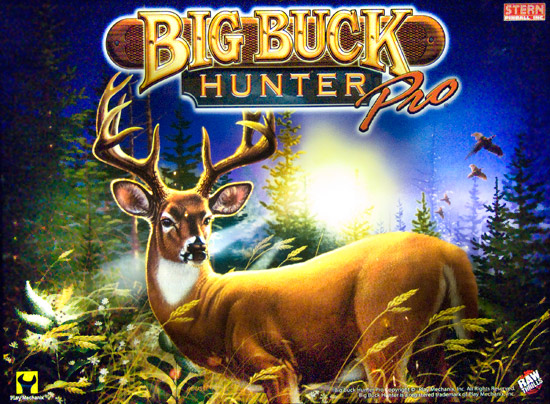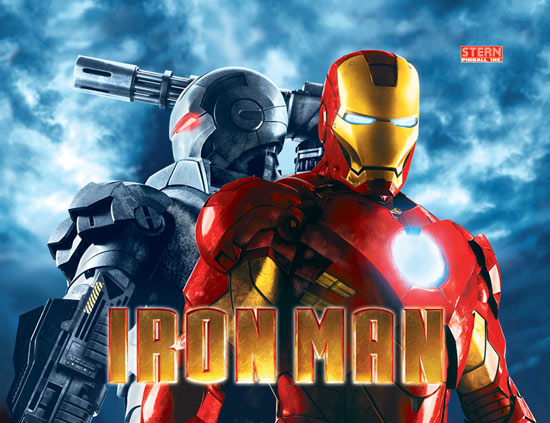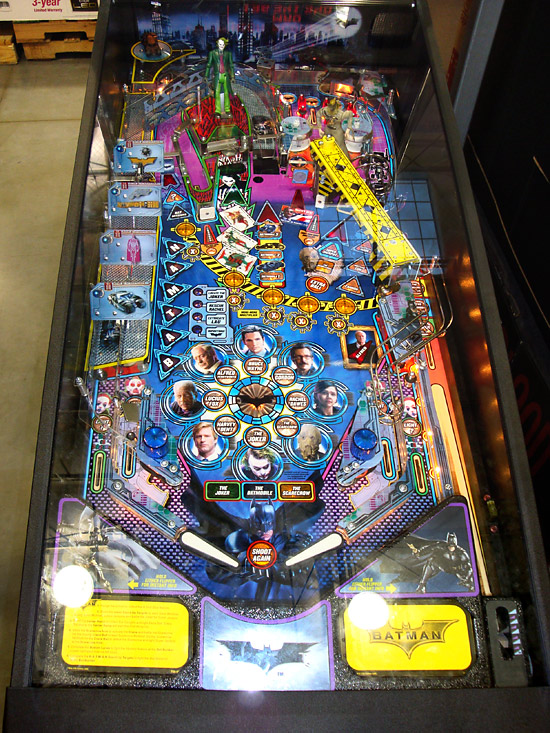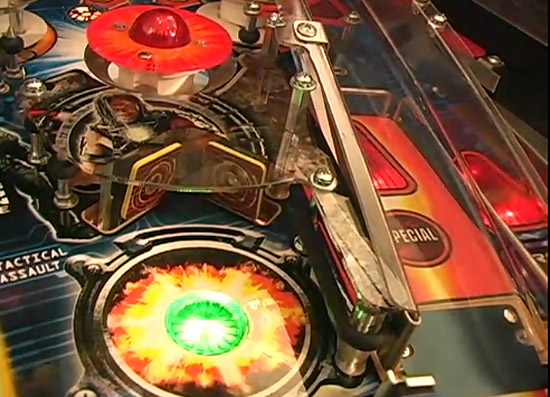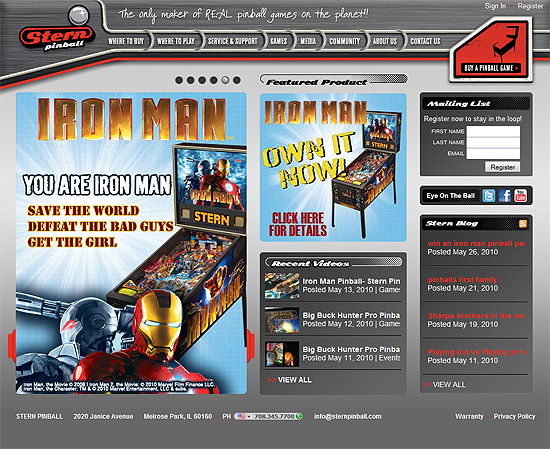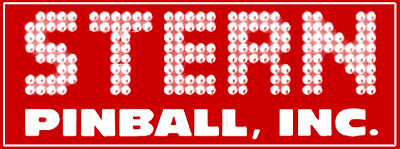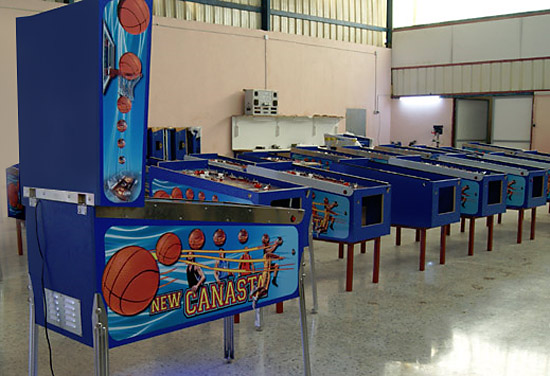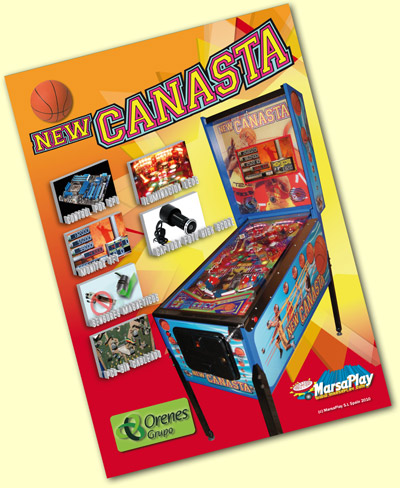| 2010 REVIEW OF THE YEAR |
Pictures by: Pinball News, Mike Ostradick & Antonio Cruz at Marsaplay Welcome to the annual look back through the mists of time, to recall the events of the past 12 months in the wonderful world of pinball.
2010 could best be described as a year of change. Familiar names took on a new look, while we welcomed a slew of new faces, companies and games, and said farewell to a few others. Let's start with the games, and 2009's NBA set the trend at Stern with all three of this year's releases continuing the simpler, cheaper, leaner design philosophy. First to go into production was Big Buck Hunter Pro in February.
Featuring a model buck which moved diagonally across the playfield, Big Buck Hunter Pro was themed on the Play Mechanix video hunting game, hoping to pick up some of the same audience and entice them to try the pinball version. Nasty rebounds saw players complaining of short ball times while tournament players tended to avoid the buck altogether in search of richer rewards elsewhere. While Big Buck Hunter Pro was an attempt to break new ground and appeal to a slightly different customer, Stern was back on familiar ground with a blockbuster action movie licence for their next release in April.
Featuring a single large playfield mechanism in the form of the Iron Monger, Iron Man excited players with it's fast action, aggressive gameplay, rock music soundtrack and disruptive playfield magnets. The playfield was lacking the custom toys from the old days but the game was still fun to play. Stern stuck with big hit movie licences for their third game of 2010 in August, and they don't get any bigger than the highest grossing movie of all time (so far); James Cameron's Avatar.
One look at the game showed where the money had been spent. The innovative 3D backglass marked out Avatar as different, as did the sparse playfield design. The music and, in particular, the sound calls were the highlights of Avatar, with the rules borrowing heavily from Iron Man. Three new models in a single year is challenging enough for Stern Pinball, but 2010 was also the year of the variant. The game you saw out on location was no longer the only version available to buy or play. Giving the standard model either liposuction or cosmetic surgery allowed stripped-down or blinged-up variants to be produced for selected designs. The first to got under the knife was Batman. Out went the Joker revolve, the mini-playfield and the teeter-totter as the 'lite' version went on sale in 16 test Costco stores across the US.
The game sold for about $700 less than the fully-featured version and was later called the 'Classic' version by Stern, with the full version being called the 'Pro' model. Although sales were sluggish when the game went on sale in May, Stern clearly saw some encouraging signs and looked for ways to further cut costs on future 'Classic' releases. It didn't take long. Just five months in fact. Already reasonably bereft of playfield features, Iron Man was the next to be cost-reduced and this time the cuts went much deeper. Out went the magnets and several of the game's flashers. The coin mech was dispensed with, as was the war machine kicker and the Whiplash toy.
The game was fixed on free play only, while the cabinet was made of MDF and sported decals instead of screen printing for the artwork when it went on sale in October. But if all the cost - and feature - cutting was getting you down, Stern also went in the opposite direction and brought out a limited edition Avatar in December with more features instead of fewer. Chrome trim, extra character models, enhanced clear coat, a motorised pod, a 'walking' AMP suit and a powerball for double scoring all added $1500 to the regular (or 'Pro') version, while the limited run of 250 ensured exclusivity for buyers who were quick to snap them up. Not content with producing new games, Stern also beefed-up their marketing push in June with a new website and steps into social marketing through Facebook and Twitter, as well as their own tightly-moderated forum.
The new website also saw the official launch of the new Stern Pinball logo. Out went:
In came:
One subtler change can be seen in the tagline at the top of the new website where it used to say "The only manufacturer of coin-op pinball on the planet". That claim came under scrutiny earlier in the year when Spanish company MarsaPlay brought out an updated version of the classic Canasta (basket) game, called New Canasta.
The game featured proximity switches instead of rollovers, LED lighting instead of lamps and PCBs under the playfield in place of wiring looms, along with an LCD monitor in the backbox for scoring and a camera to capture player images. MarsaPlay sold their initial run of 50 machines and received an order for a further 200 of the €4000 games.
If these new machines were not enough to satisfy you, new control systems for existing (or homemade) games also flourished in 2010. In February we told you about the P-ROC controller board and programming environment from Gerry Stellenberg and Adam Preble which allowed budding game designers to write their own rules, create their own dot matrix animations and mix their own sound effects. This system could then be attached to an existing driver board to either create a new game or modify and existing one. Then in December we brought you details of two people who had done just that to add new rules and a dot matrix display to a Bride of Pinbot using the P-ROC system. The P-ROC system is also adding support for Visual Pinball tables, so games developed in the pyprocgame software can be run and tested on a Visual Pinball emulation of the hardware. Meanwhile, the Nucore system for Pinball 2000 games moved forward with the introduction of new features such as a networked tournament system, improved jukebox controls and improved support for LED playfield lighting. Nucore was also part of the discussions about completing the third Pinball 2000 game, Wizard Blocks, in conjunction with Illinois Pinball. Whether that will come to fruition in the coming years or not, we'll have to wait and see but Illinois Pinball are, of course, one of the two licence holders for various Williams pinball rights. The other was Wayne Gillard of Mr Pinball Australia, but this 'year of change' saw that situation change in October, when Wayne sold those rights to a new company, Planetary Pinball Supply.
Owned and run by Rick Bartlett and Matt Christiano, the deal promised a new era of co-operation between the rights holders and the prospect of many new, licensed products coming to the market.
Matt and Rick told us all about their plans and how the deal came about. The picture above came from Pinball Expo 2010 and it was another great year for pinball shows all around the world. More shows, more visitors and more competitors belied pinball's disappearance from many of its former haunts, as nearly all 2009's shows returned and were boosted by a bunch of new events and tournaments. We tracked 77 pinball-related shows in the 2010 diary, up from 2009's figure of 65 with detailed reports from 23 of them. 2010 has also been a good 12 months for pinball museums. Business has been good and the new homes for the National Pinball Museum in Washington DC and the Silverball Museum Arcade in Asbury Park has seen the transformation from well-run attractions mainly for the pinball enthusiast, to highly professional operations appealing to the general public. In addition, The Seattle Pinball Museum opened its doors in the city's Chinatown/International district this year as well, and is open Fridays, Saturdays and Sundays, while the Pinball Hall of Fame in Las Vegas has settled into its new home as we showed with two reports this year. The Pacific Pinball Museum was also very active throughout 2010, from their help with the exhibition of pinball's development at the San Francisco International Airport to the numerous tournaments and many art exhibits at the museum's home in Alameda, the team have been spreading the word far and wide. As the popularity of pinball - at shows, in museums and online - has increased, so too have the prices of machines. The limited number (and, in some cases, limited appeal) of new models coming out of Melrose Park means members of the collector community have been looking to Ebay and similar on-line sites to add to their machine numbers. Although Ebay's fees have led many sellers to put high initial prices on their games in the hope of doing a deal outside Ebay, those initial prices are all too often seen as the actual selling price, which drives up prices overall still further. Maybe once the holiday season is over prices will drop back, but the recession doesn't seem to have killed demand for popular pinballs at premium prices. One source of new machines expected to start production this year is Retro Pinball with their King of Diamonds machine.
Although they set a delivery date of December 15th, it now looks as though this wasn't met and games won't be ready until late January or February 2011 at the earliest. On the technological front, LEDs continued to make inroads and became much more common that previously, as prices stabilised at 50c per device in #555 and #44 packages. Apart from feature lamps, aftermarket displays and specific mods, LEDs began appearing in more unusual places such as under star posts. Although the warm white colours and wider spreads improved the appearance of LEDs for general illumination use, a significant number of detractors spoke out about their inappropriate use and the unpleasant side-effects that can occur, as we discussed earlier this year. Staying with technological advances, smart phones also became more pinball-friendly with a number of apps which can help with all kinds of problems from finding a nearby game to play, to leveling your machine, to fault-finding and fixing, as Todd Andersen explained in two articles, the second of which we published this year. Pinball certainly got plenty of coverage on TV and in the press, while several pinball-specific productions saw mixed fortunes. The Special When Lit documentary continued to tour film festivals ahead of its release on DVD in January 2011, winning the audience award at the London United Film Festival. A new short film called Pinheads looking at the work of the Pacific Pinball Museum was release this year, as was a new DVD from Pinball 101 maker Randy Elwin which went in-depth into a number of historically-significant machines. On the downside though, GameRoom Magazine ceased publication after 22 years of bringing pinball, video and other coin-op news and features to subscribers, citing the 'deteriorating economic climate for print media'.
But despite the occasional casualty, pinball's 'year of change' brought overwhelmingly good news to fans of the silver ball. Contrary to some expectations, Stern Pinball is still making new games, while other companies are actively exploring the opportunities to join them (more on that later in 2011, no doubt). Pinball is still alive in the public consciousness, appearing in more and more unusual and unexpected ways, while shows and tournaments thrive despite the difficult economic times. All of which sets us up for an equally exciting and unpredictable 2011. We're certainly looking forward to the coming 12 months and reporting on them here at Pinball News just as we always have - First and Free.
© Pinball News 2010 |


